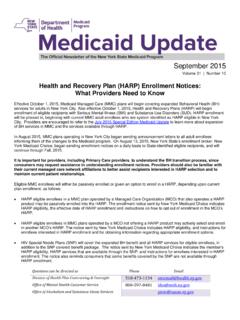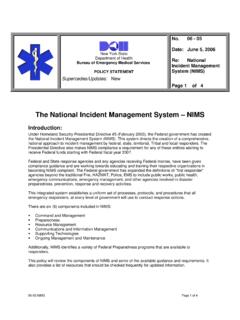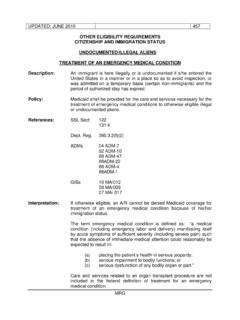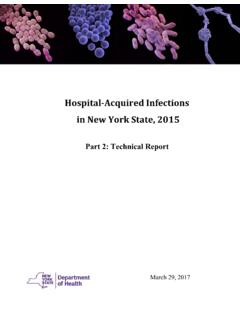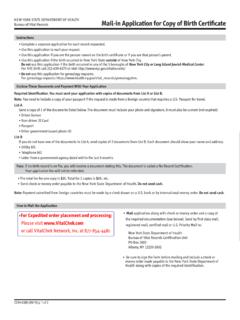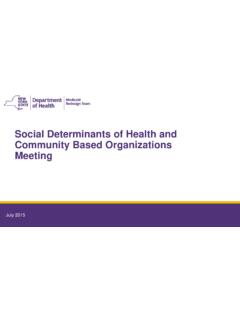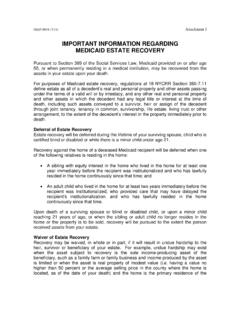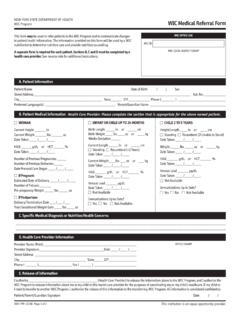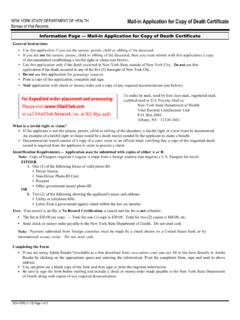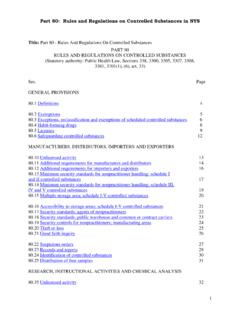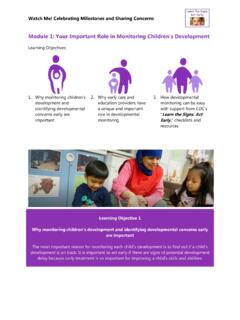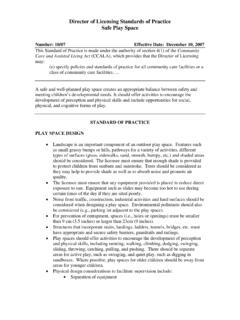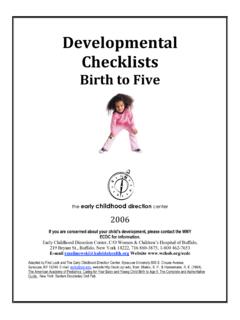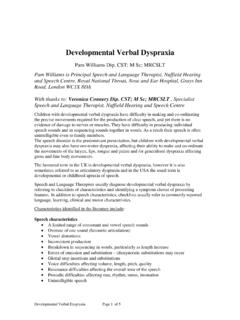Transcription of Home Care Curriculum - New York State Department of …
1 HOME CARE Curriculum NEW york State Department OF HEALTH 161 Delaware Avenue Delmar, New york 12054 Office of Health Systems Management Division of Home and Community Based Services Bureau of Home Care and Hospice Surveillance and Quality Indicators/Evaluation April 2006; January 2007 2 ACKNOWLEDGEMENTS We wish to express our gratitude and appreciation to all the people who helped in the development of this revision of the Home Care Health Related Tasks Curriculum . Staff from the New york State Department of Health (NYSDOH): Marjorie Brier-Lynch, RN, BSN Suzanne Broderick, RN, Maureen Duffy, RN, MA Priscilla Ferry, RN, BS Rebecca Fuller Gray, RN, MBA Mary G. Graziano, RN, BS Kathleen Sherry Frances Stevens Margaret Willard, MS Janice Zautner, RN Elaine Zervos, MS, RD, CDN Representatives from Licensed Home Care Service Agencies (LHCSA): Roberta Chapman, RN, BSN, Caregivers Joyce Donohue, RN, BSN, MSP, Gentiva Health Services Caroline Kenny, RN, BSN and Joyce Traina, RN, BS, Metropolitan NY Coordinating Council on Jewish Poverty Susan Trocchia, RN, People Care Elizabeth Jaiswal, RN, BSN, Partner s in Care Representatives from Certified Home Health Agencies (CHHA): Kathleen Marcais, RN, BS, Community Health Center Molly Williams, Director of Public Policy, New york State Association of Health Care Providers, Inc.
2 Melodie Bell-Cavallino, MS, RD, CDN, FADA; Chair, Nutrition Science Department ; Associate Professor; Director Dietetic Internship; Sage Graduate School; The Sage Colleges 3 INTRODUCTION TO HOME CARE Curriculum OUTLINE _____ The Home Care Curriculum is a revision of the Home Care Core Curriculum that was originally developed by the State University of New york at Buffalo under contract with the New york State Department of Social Services in 1992. This Curriculum revision is designed to replace outdated content with current standards. The revised Curriculum contains the Basic Caregiver Core Curriculum Outline [BASIC CORE]. This basic core was developed in 2002 by a workgroup composed of staff members of the New york State Department of Health, New york State Education Department , county health departments, home care providers, home care provider associations and representatives of various labor organizations.
3 The 16-hour Basic Core Curriculum provides the basis for all of the paraprofessional curricula: Personal Care Aides, Personal Care Staff (Adult Care Facilities), Home Health Aides and Certified Nurses Aides. It has been integrated into the modules of the revised Curriculum and identified in the applicable objective sections. The Home Care Curriculum contains standard written tests that must be used in combination with Performance checklists to determine the worker s successful completion of each Module. A Personal Care Aide certificate will be issued to the student upon successful completion of the 40-hour training program. The original Home Care Core Curriculum may be used as an adjunct to the information contained in the revised objectives and outline. Other resources may be used at the discretion of the Registered Professional Nurses supervising the approved Personal Care Aide/Home Health Aide Training Programs.
4 Infection Control The Center for Disease Control (CDC) standard precaution guidelines, especially handwashing and personal protective equipment must be strictly adhered to and is included throughout all Modules 4 MANUAL USE _____ This manual has been developed in an outline format. Each Module covers a specific subject and contains: Objective section including a Module title, description of each unit, minimum time required to complete objectives, objectives, some measurable performance criteria and suggested teaching and evaluation methodologies Outline section Evaluation section consisting of test questions with an answer key. The Appendix includes all Procedures. These procedures are to be taught and demonstrated to the student. The minimum time required includes time it takes to instruct and demonstrate the required skills. Required and Optional Procedures: Each of the procedures in Module XII has a companion checklist for evaluation purposes.
5 As a practical matter it may not be possible to evaluate the trainee on every procedure. However, there are certain basic procedures the trainee should be required to demonstrate. It is recommended that the trainee pass twelve required procedures plus at least two other optional procedures of the trainers choosing. These optional procedures should be related to the typical caseload or other needs of the agency. Asterisks on the summary chart and on the individual procedures indicate the twelve required procedures. The major modules of the Home Care Curriculum are derived from the Level I and II, Personal Care Aide, Scope of Functions and Tasks, developed by the New york State Department of Social Services and last amended on 12/1/94. The revised objectives and outline must be followed and all material must be covered. 5 TABLE OF CONTENTS _____ PAGES Acknowledgements 2 Introduction to Home Care Curriculum 3 Manual Use 4 Table of Contents 5 Appendix 9 Core Value Statement 10 Module I.
6 Introduction to Home Care 11 Unit A. Home Care, the Home Care Worker and the Client Unit B. What is a Home Care Worker? Unit C. Providing Home Care Module II. Working Effectively with Home Care Clients 15 Unit A. Theories of Basic Human Needs Unit B. Diversity Unit C. Communication and Interpersonal Skills Unit D. Caregiver Observation, Recording and Reporting Unit E. Confidentiality Module III. Working with the Elderly 24 Unit A. What is Aging Unit B. Aging and the Body/Body Systems Unit C. Aging and the Mind Module IV. Working with Children 27 Unit A.
7 Family Situations in which children may need home care workers Unit B. How children develop and how to work with them Unit C. Problems that affect the family and how children react to stress Unit D. How you can help strengthen families through work with parents or caregivers 6 Module V. Working with People who are Mentally Ill 30 Unit A. What is Mental Health? Unit B. What is Mental Illness? Unit C. Mental Health, Mental Illness, and the Home Care Worker Module VI. Working with People with Developmental Disabilities 33 Unit A. Understanding Developmental Disabilities Unit B. Developmental Disabilities and Home Care Module VII. Working with People with Physical Disabilities 36 Unit A. What is physical disability? Unit B. How the Home Care Worker can help the physically disabled. Module VIII. Food Nutrition and Meal Preparation 38 Unit A. The Major Nutrients Unit B.
8 Meal Planning Unit C. Food Preparation and Serving Unit D. Food Shopping, Storage and Handling Food Safely Unit E. Modified Diets Module IX. Family Spending and Budgeting 50 Unit A. The role of the Home Care Worker in family spending and budgeting Unit B. Ways to make the most effective use of the families finances Module X. Care of the Home and Personal Belongings 52 Unit A. Importance of Housekeeping in Home Care Unit B. Performing housekeeping in the Home Unit C. Ways to be safe and save energy and time. Unit D. How to get the job done. Module XI. Safety and Injury Prevention 56 Unit A. Injuries Unit B. Injury Prevention Unit C. What to do when injuries and emergencies happen Module XII.
9 Personal Care Unit A. Defining Personal Care 61 7 Unit B. Personal Care Skills A) Handwashing 62 B) Infection Control 63 Lesson 1. Process of Infection Lesson 2. Standard Precautions Lesson 3. Bloodborne Pathogens Lesson 4. Exposure Incidents C) Freedom from Pain 65 Lesson 1. Pain Management Lesson 2.
10 Recognizing and Reporting Pain D) Urinary System 67 Lesson 1. Assisting with Bedpan/Urinal/Fracture Pan Lesson 2. Bedside Commode/Toilet Lesson 3. Incontinence E) Digestive Systems 73 Lesson 1. Nutrition and a Balanced Diet (see Module VIII) Lesson 2. Assisting with Eating and Hydration a) Proper Feeding Techniques 1) Positioning 2) Assistance for Independent Eaters 3) Partial Assistance with Eating Lesson 3. Measuring and Recording Weight F) Integumentary System 78 Lesson 1. Skin Care and Alterations in Skin a) Healthy Skin G) Musculoskeletal System 83 Lesson 1.
